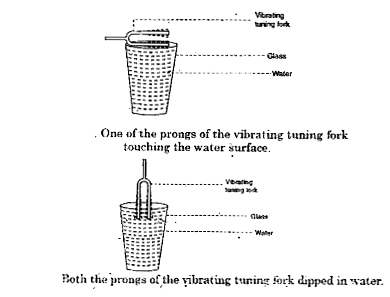Complete Solutions to Activity of chapter SOUND of Class 9 book with complete answers and questions
| Class 9 | PHYSICS |
| Chapter | SOUND |
| NAND LAL PUBLICATION | Activity |
| Number Of Questions | 11 |
| Academic Year | 2023-24 |
Take a tuning fork and set it to vibration by striking its prong on a rubber pad.
What will you find it you bring the vibrating tuning fork near your ear?
View SolutionTake a tuning fork and set it to vibration by striking its prong on a rubber pad.
What will you find it you bring the vibrating tuning fork near your ear?
View SolutionSuspend a table tennis ball or a small plastic ball by a thread from a support. You can suspend the ball using thread and a needle. Take a big needle and a thread, put a knot at one end of the thread. Then with tshe help of needle pass the thread through the ball.

What will happen if you touch the ball with prong of the tuning fork without setting it into vibration?
View SolutionSuspend a table tennis ball or a small plastic ball by a thread from a support. You can suspend the ball using thread and a needle. Take a big needle and a thread, put a knot at one end of the thread. Then with tshe help of needle pass the thread through the ball.

What will happen if you touch the ball with a vibrating tuning fork?
View SolutionFill water in a beaker or a glass up to its brim. Gently touch the water surface with one of the prongs of the vibrating tuning fork as shown in Fig. 12.2. Now dip the prongs of vibrating tuning fork in water as shown in Fig. 12.3

Observe what happens in both the cases?
View SolutionFill water in a beaker or a glass up to its brim. Gently touch the water surface with one of the prongs of the vibrating tuning fork as shown in Fig. 12.2. Now dip the prongs of vibrating tuning fork in water as shown in Fig. 12.3

Discuss with your friends why this happens.
View SolutionFill water in a beaker or a glass up to its brim. Gently touch the water surface with one of the prongs of the vibrating tuning fork as shown in Fig. 12.2. Now dip the prongs of vibrating tuning fork in water as shown in Fig. 12.3

What can you conclude from activity 12.1 and 12.2?
View SolutionMake a list of different types of musical instruments and discuss with your friends which part of the instrument vibrates to produce sound.
View SolutionTake a slinky. Ask your friend to hold one end. You hold the other end. Now stretch the slinky as shown in Fig. 12.8 (a) Then give it a sharp push towards your friends.
What do you notice ? If you move your hand pushing and pulling the slinky alternatively, what will you observe?
If you mark a dot on the slinky, you will observe that the dot on the slinky will move back and forth parallel to the direction of the propagation of the disturbance.

View SolutionTake two identical pipes, as shown in Fig 12.23. You can make the pipe using chart paper. The length of the pipes should be sufficiently long as shown paper. Arrange them on a table near a wall. Keep a clock near the open end of one of the pipes, say pipe A and try to hear the sound of the clock through the other pipe. Put a playwood sheet between the two tubes perpendicular to the wall. This does not allow the direct hearing of the ticking sound of the clock. Ajust the position of the pipes so that you can best hear the sound of the clock.

Now measure the angles of incidence and reflection and see the relationship between the angles.
View SolutionTake two identical pipes, as shown in Fig 12.23. You can make the pipe using chart paper. The length of the pipes should be sufficiently long as shown paper. Arrange them on a table near a wall. Keep a clock near the open end of one of the pipes, say pipe A and try to hear the sound of the clock through the other pipe. Put a playwood sheet between the two tubes perpendicular to the wall. This does not allow the direct hearing of the ticking sound of the clock. Ajust the position of the pipes so that you can best hear the sound of the clock.

Lift the pipe on the right vertically to a small height and observe what happens?
View Solution
Activity questions and complete solutions for chapter SOUND of NAND LAL PUBLICATION of Class 9